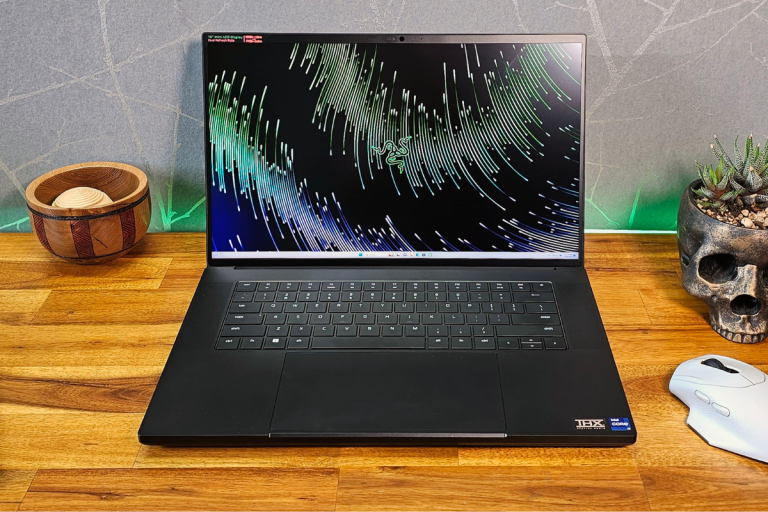5 Best Laptops for electrical engineering
Are you tired of endless searches for the perfect laptop for your electrical engineering needs? Look no further! In this blog post, we will explore the top choices that will power up your projects and make your studies a breeze.
Best laptop for electrical engineering
| S.No. | Product Name | Check price |
| 1. | Dell XPS 15 | Check price |
| 2. | MacBook Pro | Check price |
| 3. | ASUS ZenBook Pro Duo | Check price |
| 4. | HP Spectre x360 | Check price |
| 5. | Lenovo ThinkPad P52 | Check price |
1. Dell XPS 15
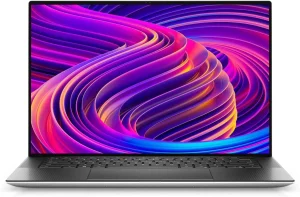
| Specifications | Details |
| Processor | Intel 11th Generation Core i7-11800H 2.30GHz |
| Display | 15.6″ 3456 x 2160 TouchScreen |
| Graphics Card | NVIDIA RTX 3050 4GB GDDR6 |
| RAM | 16GB DDR4 |
| Storage | 512GB NVMe SSD |
| Operating System | Windows 10 Professional |
Hey there! So, I’ve had the pleasure of getting my hands on the Dell XPS 15, and let me tell you, it’s a game-changer for us electrical engineering enthusiasts. The Intel Core i7 processor is like a trusty sidekick, always ready to tackle those demanding simulations and designs with ease.
The 15.6″ touchscreen display is a sight to behold, perfect for scrutinizing intricate circuit diagrams. And let’s not forget about the NVIDIA RTX 3050 graphics card – it’s like having a secret weapon for seamless 3D modeling.
With 16GB of DDR4 RAM and a blazing-fast 512GB NVMe SSD, this laptop boots up quicker than you can say “electromagnetic field.” The Windows 10 Professional OS is a breath of fresh air, free from all that pesky bloatware that usually clutters up new laptops.
Pros:
- Powerful Intel Core i7 processor
- Stunning touchscreen display
- Dedicated NVIDIA graphics card for smooth 3D rendering
- Speedy 16GB DDR4 RAM and 512GB NVMe SSD
- Clean Windows 10 Professional installation
Cons:
- The price might be a bit steep for those on a budget
- Touchscreen feature may not be a necessity for all engineering tasks
2. MacBook Pro

| Specifications | Details |
| Chip | Apple-designed M1 |
| Battery Life | Up to 20 hours |
| CPU | 8-core CPU |
| GPU | 8-core GPU |
| Neural Engine | 16-core Neural Engine |
| Memory | 8GB unified memory |
Ah, the MacBook Pro, the knight in shining aluminum armor for us electrical engineering wizards. The Apple-designed M1 chip is a game-changer, delivering mind-blowing performance in CPU, GPU, and machine learning realms. With up to 20 hours of battery life, I could tinker and troubleshoot to my heart’s content without worrying about running out of juice.
The 8-core CPU is a speed demon, zipping through workflows with a swiftness that would make The Flash jealous. And don’t even get me started on the 8-core GPU – it’s like having a personal graphics powerhouse at my fingertips.
Thanks to the 16-core Neural Engine, I could delve into advanced machine learning projects with ease. And with 8GB of unified memory, everything on this MacBook Pro felt smooth and seamless.
Pros:
- Blazing-fast Apple-designed M1 chip
- Impressive 20-hour battery life
- Speedy 8-core CPU and GPU for lightning-fast performance
- Advanced 16-core Neural Engine for machine learning tasks
- Snappy SSD storage for quick app launches
Cons:
- Limited upgrade options compared to other laptops
- A higher price point may be a barrier to some budgets
3. ASUS ZenBook Pro Duo
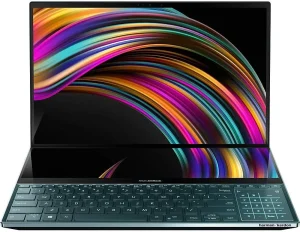
| Specifications | Details |
| ScreenPad Plus | 14-inch 4K matte touchscreen |
| Main Display | 15.6-inch 4K UHD NanoEdge glossy touchscreen |
| Processor | 9th gen Intel Core i7-9750H Quad Core with NVIDIA GeForce RTX 2060 |
| Storage | 1TB PCIe NVMe SSD |
| Memory | 16GB DDR4 RAM |
| Additional Features | Detachable palm rest, ASUS active stylus pen included |
Ah, the ASUS ZenBook Pro Duo, a double dose of screens and power for us electrical engineering maestros. Let me take you on a journey through my experience with this innovative device.
The ScreenPad Plus, a 14-inch 4K matte touchscreen, is a multitasker’s dream, allowing me to easily optimize my workflow by extending screens or splitting windows and apps. Coupled with the 15.6-inch 4K UHD NanoEdge main display, I had a visual feast at my fingertips.
The 9th gen Intel Core i7 processor and NVIDIA GeForce RTX 2060 GPU were a dynamic duo, handling demanding engineering tasks with grace and speed. With a spacious 1TB PCIe NVMe SSD and 16GB of DDR4 RAM, storage and memory were never a bottleneck for my projects.
Pros:
- Dual-screen setup for enhanced multitasking
- Powerful Intel Core i7 processor and NVIDIA GeForce RTX 2060 GPU
- Generous storage and memory configuration
- Detachable palm rest and ASUS active stylus for added convenience
Cons:
- Weight and size may be cumbersome for some users
- Higher price point compared to traditional laptops
4. HP Spectre x360
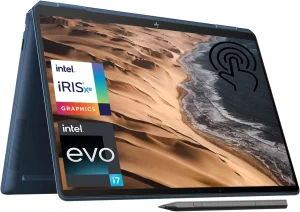
| Specifications | Details |
| RAM | 16GB high-bandwidth RAM |
| Storage | 512GB PCIe NVME M.2 Solid State Drive |
| Processor | Intel Evo platform 12th Gen Core i7-12700H with Intel Iris Xe Graphics |
| Display | 16-inch 3K+ multitouch-enabled IPS display with Corning Gorilla Glass |
| Connectivity | 2 x Thunderbolt 4, 1 x USB Type-A, 1 x HDMI 2.1, Wi-Fi 6E, Bluetooth |
| Additional Features | Backlit keyboard, Fingerprint reader, HP Rechargeable MPP 2.0 Tilt Pen |
Welcome to the HP Spectre x360, where versatility meets power in a sleek package designed to elevate your electrical engineering experience.
The 16GB high-bandwidth RAM and 512GB PCIe NVME SSD make multitasking a breeze, allowing me to juggle multiple applications effortlessly. The Intel Evo Core i7 processor with Iris Xe Graphics delivers smooth performance for my engineering tasks, from simulations to coding.
The 16-inch 3K+ multitouch display is a visual marvel, offering crisp detail and vibrant colors for a truly immersive viewing experience. With a range of connectivity options including Thunderbolt 4 and Wi-Fi 6E, staying connected and productive is a seamless affair.
Pros:
- High-performance Intel Evo Core i7 processor
- Stunning 3K+ multitouch display with Corning Gorilla Glass
- Versatile connectivity options including Thunderbolt 4 and Wi-Fi 6E
- Backlit keyboard and HP Rechargeable MPP 2.0 Tilt Pen for enhanced usability
Cons:
- Limited storage capacity compared to other models
- Higher price point for premium features
5. Lenovo ThinkPad P52
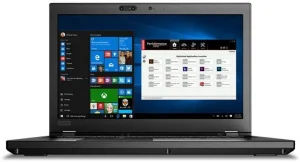
| Specifications | Details |
| RAM | 16GB high-bandwidth RAM |
| Storage | 512GB PCIe NVME M.2 Solid State Drive |
| Processor | Intel Evo platform 12th Gen Core i7-12700H with Intel Iris Xe Graphics |
| Display | 16-inch 3K+ multitouch-enabled IPS display with Corning Gorilla Glass |
| Connectivity | 2 x Thunderbolt 4, 1 x USB Type-A, 1 x HDMI 2.1, Wi-Fi 6E, Bluetooth |
| Additional Features | Backlit keyboard, Fingerprint reader, HP Rechargeable MPP 2.0 Tilt Pen |
Welcome to the HP Spectre x360, where versatility meets power in a sleek package designed to elevate your electrical engineering experience.
The 16GB high-bandwidth RAM and 512GB PCIe NVME SSD make multitasking a breeze, allowing me to juggle multiple applications effortlessly. The Intel Evo Core i7 processor with Iris Xe Graphics delivers smooth performance for my engineering tasks, from simulations to coding.
The 16-inch 3K+ multitouch display is a visual marvel, offering crisp detail and vibrant colors for a truly immersive viewing experience. With a range of connectivity options including Thunderbolt 4 and Wi-Fi 6E, staying connected and productive is a seamless affair.
Pros:
- High-performance Intel Evo Core i7 processor
- Stunning 3K+ multitouch display with Corning Gorilla Glass
- Versatile connectivity options including Thunderbolt 4 and Wi-Fi 6E
- Backlit keyboard and HP Rechargeable MPP 2.0 Tilt Pen for enhanced usability
Cons:
- Limited storage capacity compared to other models
- Higher price point for premium features
A Comprehensive Buying Guide for Choosing the Best Laptop for Electrical Engineering
As an expert in the field of electrical engineering, I understand the importance of selecting the right laptop that caters to your specific needs and requirements. Here are six crucial factors to consider when choosing the best laptop for electrical engineering:
- Performance: Opt for a laptop with a powerful processor and ample RAM to handle resource-intensive engineering software and multitasking with ease. Look for models with Intel Core i7 or higher processors and at least 16GB of RAM for optimal performance.
- Storage: Consider the storage capacity of the laptop, especially if you work with large files and datasets. Solid State Drives (SSDs) offer faster data access speeds compared to traditional Hard Disk Drives (HDDs), making them ideal for quick boot-up times and efficient data transfer.
- Display: Choose a laptop with a high-resolution display that provides sharp visuals and accurate color reproduction. A larger screen size, such as 16 inches or above, can enhance your productivity by allowing for better multitasking and improved workflow efficiency.
- Connectivity: Ensure the laptop offers a range of connectivity options such as Thunderbolt ports, USB Type-A and Type-C ports, HDMI, and Wi-Fi 6E for seamless communication and data transfer with external devices and networks.
- Battery Life: Look for a laptop with long battery life to sustain your work throughout the day without frequent recharging. A laptop with rapid charging capabilities can be advantageous for quick top-ups when needed.
- Additional Features: Consider additional features such as a backlit keyboard, fingerprint reader, stylus support, and ergonomic design elements that enhance usability and comfort during prolonged use.
FAQs
1. What is the ideal processor for a laptop meant for electrical engineering tasks?
A laptop with an Intel Core i7 processor or higher is recommended for optimal performance in handling engineering software and multitasking.
2. How much RAM should a laptop have to meet the requirements of electrical engineering applications?
A minimum of 16GB of RAM is advisable to ensure the smooth operation of resource-intensive engineering software and tasks.
3. Is it necessary to have a dedicated graphics card in a laptop for electrical engineering work?
While a dedicated graphics card can enhance performance for certain engineering tasks, it is optional for most electrical engineering applications.
4. What type of storage drive is preferable for storing large engineering files on a laptop?
Opt for a Solid State Drive (SSD) over a traditional Hard Disk Drive (HDD) for faster data access speeds and improved efficiency in handling large datasets.
5. Are there any specific display specifications to look for in a laptop for electrical engineering purposes?
Choose a laptop with a high-resolution display and a screen size of 15 inches or above to facilitate detailed visual work and multitasking capabilities essential for electrical engineering tasks.
Conclusion
Selecting the best laptop for electrical engineering involves considering factors such as performance, storage, display quality, connectivity options, battery life, and additional features.
By understanding your specific needs and prioritizing these key elements, you can ensure that the laptop you choose enhances your productivity and efficiency in handling complex engineering tasks. Remember to balance power and portability to find the perfect match that aligns with your requirements and budget.
